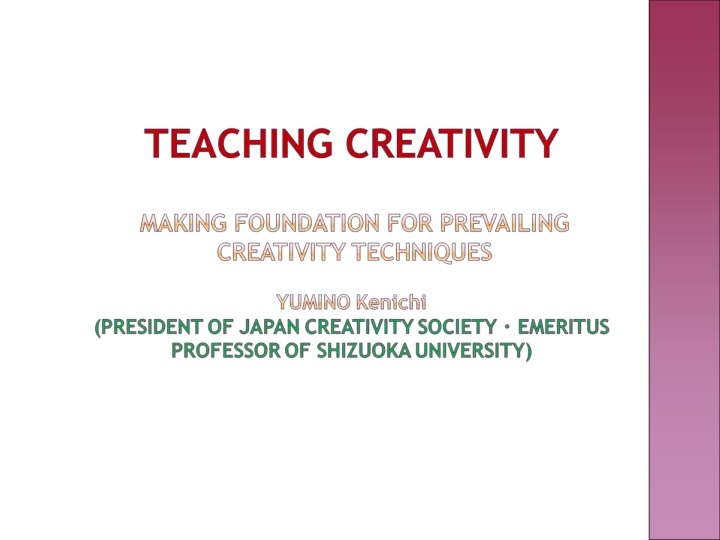



YAMAKAWA Kenjiro (President of Kyusyu-Imperial University,1911) <Career> 嘉永 7 年( 1954 )会津生まれ 慶應 4 年( 1868 )戊申戦争に参加 明治 4 年( 1871 )アメリカに留学 明治 12 年( 1879 )日本初の物理学教授 明治 34 年( 1901 )東京帝国大学総長 明治 44 年( 1911 )九州帝国大学初代総長 He said following words to Students. Japanese students make attention to “ How ”, but never say “ Why ”. A hundred years later, this words alive as a weakness of Japan Education.
Recent Japan– One of Advanced Nations in Sci. & Tech. Basic Education for Creating /Developing Sci. & Tech. lacks in Japan’s School Education. Creating /Developing Sci. & Tech. require “What”, ”Why”, ”How” Questions. “How Questions” are important in Japan Society/Schools which put high value on “Learning: Manabi” Together with “How-Questions”, ”What-” & “Why-” Questions are heavily important in the Western Society/Schools.
What is Learning(Manabi)? It is said that the origin of a word " Manabi :learning:" is "to imitate something." In the case, it needs two persons(objects), those who imitate, and those who are imitated (objects) . Objects Include language, new knowledge, action, skill, value, liking, etc. People gain those objects through books and textbooks, various kinds of media, teachers, parents, a family, friends, and society. What is Creation(Tsukuri)? Difference of “make “and “create”. ・ Make: Based on a model/plan, complete a product. ・ Create: Not imitate others, but complete a product in own original way. ⇒ Encourage Tsukuri is essential for Creativity Education.
Manabi Tsukuri ① Create S Not Include Include tudy, S ci. & Tech. ② Efficiency of Learning High Low ③ Truth or False of Material True Need Judge ④ S cope of Knowledge Narrow Broad ⑤ Forgetting Knowledge Easy S trong ⑥ Responsibility to Learning Low/ Middle High ⑦ Confidence in Knowledge Low High ⑧ S elf Involvement Low High ⑨ Discussion Little Often ⑩ Usable Knowledge for Discussion Confident Not Confident ⑪ Enlargement of Creativity Not Expected Expected ⑫ Atmosphere of the Place S erious Free and Easy
Japanese S chools There is little Tsukuri Lesson except Art & Integrated Study. The western school (USA, Canada, German, Finland, France) lessons always include Tsukuri. Example: 「 Creative Writing 」 「 Drama 」 Example: <Japan> Subtraction ⇒「 12-7 」。 <USA> How could you divide 12 in two parts. <Finland> Using Keyword “good treat”, students planed to make a memorial birthday party. Students thought celebration words, music, decoration, foods, etc.
Reading Comprehension in Japan ⇒ To comprehend an intension and emotion of the author. Reading Comprehension in the West ⇒ To comprehend multiple sentences, and add learner’ opinion. Example: 2 different opinions concerning graffiti. ⇒ Which opinion do you agree? Citing one or another opinion, complete your answer using your own words. ⇒ Japanese Schools recently noticed Western Type Reading Comprehension.
『落書き』学校の壁の落書きに頭に来ています。壁から落書きを消して塗り直すのは、今度が 4 度目だ からです。想像力という点では見上げたものだけれど、社会に余分な損失を負担させないで、自分を 表現する方法を探すべきです。 禁じられている場所に落書きをするという、若い人たちの評価を落とすようなことを、なぜするので しょう。プロの芸術家は、通りに絵をつるしたりなんかしないで、正式な場所に展示して、金銭的援助を 求め、名声を獲得するのではないでしょうか。 わたしの考えでは、建物やフェンス、公園のベンチは、それ自体がすでに芸術作品です。落書きでそ うした建築物を台なしにするというのは、ほんとに悲しいことです。それだけではなくて、落書きという手 段は、オゾン層を破壊します。そうした「芸術作品」は、そのたび消されてしまうのに、この犯罪的な芸 術家達はなぜ落書きをして困らせるのか、本当に私は理解できません。 ヘルガ 『十人十色』人の好みなんてさまざまです。世の中はコミュニケーションと広告であふれています。企業 のロゴ、お店の看板、通りに面した大きくて目障りなポスター。こういうのは許されるでしょうか。そう、 大抵は許されます。では、落書きは許されますか。許せるという人もいれば、許せないという人もいま す。 落書きのための代金はだれが払うのでしょう。だれが最後に広告の代金を払うのでしょう。その通り、 消費者です。 看板を立てた人は、あなたに許可を求めましたか。求めてはいません。それでは、落書きをする人は 許可を求めなければいけませんか。これは単に、コミュニケーションの問題ではないでしょうか。あなた 自身の名前も、非行グループの名前も、通りで見かける大きな制作物も、一種のコミュニケーションで はないかしら。 数年前に店で見かけた、しま模様やチェックの柄の洋服はどうでしょう。それにスキーウェアも。そう した洋服の模様や色は、花模様が描かれたコンクリートの壁をそっくりそのまま真似たものです。そう した模様や色は受け入れられ、高く評価されているのに、それと同じスタイルの落書きが不愉快とみな されているなんて、笑ってしまいます。 芸術多難の時代です。 ソフィア
Japan ⇒ Manabi is main stream of learning. Manabi needs a model, textbook, theory, behavior of a teacher, value, etc. Intellectual ability in Manabi is “ Intelligence “ . The speed of understanding & memorization of the textbook, which characterizes Japan’ s education, is closely related with Intelligence.
I/ S elf is profoundly related to Tsukuri . “ My Opinion” , “ My Thought” , “ My Expression” , “ Things that represent me” The most excellent product which appears in encouraging Tsukuri process is corresponds to creativity of the child . Important: Tsukuri requires a lot of failures, trials and errors.
Behavior of S cold includes, ① Your behavior is wrong. Judging from my “ right model” , your behavior is deviated. ② I’ d like to correct or prohibit your wrong behavior. ③ I’ m a matured teacher, on the contrary, you a immature learner. ④ Furthermore, it also contains the implications of making his/ her best doing towards a goal by appealing to his/ her feelings.
① S colding includes strong negative feelings. ② A learner never know at first time his behavior (statement) was wrong or his opinion was impudent in front of older people(teachers, parents, senior fellows). ③ When a child scolded strongly in front of people, he will liable to avoid to express his opinion or making discussion in order to maintain self-respect feeling. ④ In case of scolding, it needs that the reasons to scold and to tell him them.
Praising includes, ① Your doing is right. ② Your doing is superior. ③ Continue your doing now. ④ I admit you. ⑤ I much admire you.
Scolding is divided in two parts: ① A feedback information(your doing is wrong) to the learner. ② Putting the learner an emotional punishment. We can find another part exists between two parts, that is, “correcting” which has no emotional tone. ③ When trying to develop a child‘s creativity, scolding should minimize, instead of it, education that uses correcting and praising may effective.
① A child never notice a right model and direction, only j ust has scolding without correcting. ② When a child always scolded without correcting, he does not understand the right model or direction of acting that he refers after that. ③ Neither individuality nor creativity will be realized without accepting an opinion and expression of every child as a valuable thing. Hitherto, there are a lot of right models. ④ At the atmosphere under scolding, creative idea never produces. At the atmosphere under praising, individuality and creativity may be fostered.
① S ensibility to the problem ② Fluency of thinking(number of ideas ) ③ Flexibility of thinking(a variety of ideas) ④ Originality of thinking ・ Originality in group ・ Originality in individual ⑤ Elaboration of thinking ⑥ Ability to redefine
Recommend
More recommend